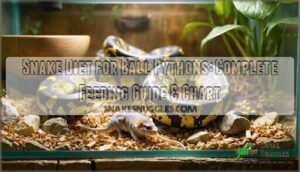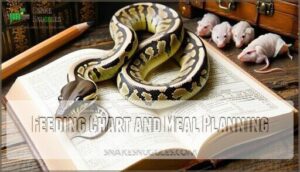This site is supported by our readers. We may earn a commission, at no cost to you, if you purchase through links.

Choose commercially bred rodents over wild-caught prey for safety. Thaw frozen prey in your refrigerator overnight, then warm it to 98-100°F in water before feeding.
Hatchlings eat every 5-7 days, juveniles every 7-10 days, and adults every 10-21 days. Monitor weight monthly to prevent obesity.
Provide fresh water daily, but avoid distilled water. Feed inside the enclosure using tongs to reduce stress and avoid bites.
The right feeding approach keeps your python healthy and content, but mastering the nuances of prey preparation and timing makes all the difference.
Table Of Contents
- Key Takeaways
- Choosing The Right Prey
- Preparing Frozen Prey
- Feeding Frequency and Weight Management
- Nutritional Supplements for Ball Pythons
- Safe Feeding Practices
- Prey Refusal and Feeding Challenges
- Water Needs and Hydration
- Feeding Chart and Meal Planning
- Common Feeding Mistakes to Avoid
- Frequently Asked Questions (FAQs)
- What is the best diet for a ball python?
- What can I feed my ball python if I don’t have mice?
- What can ball pythons not eat?
- What to feed a picky ball python?
- How often should I handle my ball python after feeding?
- What are the signs that my ball python is overweight?
- How do I transition my ball python to a new prey type?
- What should I do if my ball python refuses to eat?
- Can ball pythons eat eggs or chicks?
- How long can ball pythons fast safely?
- Conclusion
Key Takeaways
- Feed frozen-thawed mice and rats that weigh 10-15% of your python’s body weight – this prevents obesity while ensuring proper nutrition
- Follow age-appropriate feeding schedules – hatchlings need food every 5-7 days, juveniles every 7-10 days, and adults every 10-21 days
- Always thaw prey in the refrigerator overnight and warm it to 98-100°F before feeding to prevent bacterial growth and make it appealing
- Use feeding tongs and feed inside the enclosure to reduce stress and prevent bites while creating a safer feeding experience for both you and your snake
Choosing The Right Prey
Choosing the right prey for your ball python isn’t rocket science, but it makes all the difference in keeping your snake healthy and happy.
You’ll need to take into account prey type, size, nutritional value, and where you source your feeders to give your python the best diet possible.
Types of Prey for Ball Pythons
Your ball python’s wild diet consists mainly of rodents like mice and rats, with occasional birds or lizards.
In captivity, stick to commercially bred mice and rats for the best rodent nutrition.
While bird variety and alternative prey exist, ball pythons adapt poorly to new foods as they age, making consistent prey sourcing essential for reliable feeding success.
Some owners find success with rats as a nutritious choice for their ball pythons.
How to Select Prey Based on Snake Size
Choose prey that’s 10-15% of your ball python’s body weight – about 1 to 1.25 times their mid-body diameter.
A 500-gram snake needs roughly 50-75 gram prey items.
Young pythons start with adult mice, while mature snakes graduate to small rats.
Visual assessment tips: the prey should create a slight bulge when swallowed, not disappear completely or stretch your snake uncomfortably, following the rule of prey size relative to the snake’s body weight.
Importance of Prey Variety for Nutrition
Your ball python’s nutritional balance thrives on prey variety rather than monotonous meals.
Rodent profiles differ substantially – mice offer balanced protein while rats provide higher fat content.
Adding bird supplementation like chicks boosts vitamin A and taurine levels.
This nutrient diversity creates a complete nutrition profile, preventing deficiencies and supporting ideal health in your ball python diet.
Where to Buy Prey for Ball Pythons
Smart shoppers know where to find the best frozen mice snakes need.
Online retailers and local breeders provide superior quality assurance while minimizing salmonella risks compared to pet stores.
These reptile food sources offer fresher inventory and better storage practices for your ball python diet.
Reputable vendors provide various frozen options for snake owners.
Buying bulk from reputable suppliers saves money and guarantees consistent prey availability for maximum nutrition.
Preparing Frozen Prey
Proper preparation of frozen prey guarantees your ball python receives safe, nutritious meals while preventing bacterial growth that could harm your pet.
You’ll need to follow specific thawing and warming steps to make frozen rodents appealing and digestible for your snake.
Thawing Prey in The Refrigerator Overnight
Proper thawing prevents bacterial growth and nutritional loss in your ball python diet.
Always thaw frozen-thawed prey in the fridge for 12-24 hours to maintain safe temperatures and preserve nutrients.
- Thawing duration: Allow 12-24 hours for complete thawing
- Fridge temperature: Keep at 40°F or below to prevent bacterial growth
- Safety concerns: Never thaw at room temperature – this creates dangerous bacteria
This slow process keeps your snake’s frozen food safe while maintaining nutritional integrity for ideal snake diet health.
Warming Prey in Warm Water Before Feeding
After thawing, you’ll need to warm your frozen-thawed rodents to make them appetizing for your ball python. Water temperature matters – aim for that perfect 98-100°F sweet spot that mimics natural body heat.
- Fill a container with warm water (98-100°F)
- Submerge the thawed prey for 15-30 minutes
- Check temperature with a thermometer before serving
- This palatability enhancement triggers your snake’s feeding response while preventing bacterial growth
Consider using products designed for a consistent water temperature.
Using a BPA-Free Plastic Bag for Warming
When warming frozen-thawed rodents for ball python feeding, place the prey inside a BPA-free bag to prevent chemical contamination.
These bag alternatives protect your snake from BPA risks while maintaining safe handling practices.
Seal the bag tightly, then submerge in warm water for effective warming methods.
This technique guarantees temperature control without exposing frozen rodents to harmful plastics during thawing prey preparation.
Checking Prey Temperature With a Temperature Gun
After warming your prey in that BPA-free bag, grab your temperature gun to check the reading accuracy. Think of it as your precision thermometer ensuring proper temperature for safe ball python feeding.
Checking reptile temperature accurately is vital for their well-being.
Here’s your temperature checklist:
- Gun calibration – Test on known temperatures first
- Temperature range should hit 98-100°F exactly
- Safety concerns – Temperatures below 95°F risk bacterial growth
- Reading accuracy – Point at thickest part of thawed rodent
Your snake’s health depends on getting this right every time.
Feeding Frequency and Weight Management
Getting the feeding schedule right for your ball python isn’t just about dropping food in the tank—it’s about matching your snake’s age, size, and activity level to prevent both obesity and malnutrition.
You’ll need to monitor your python’s weight regularly and adjust meal frequency as they grow from hungry hatchlings to laid-back adults, which involves considering their activity level.
Feeding Schedule for Hatchlings, Juveniles, and Adults
Ball python feeding frequency depends on age and size.
Hatchling frequency starts at every 5-7 days, while juvenile intervals extend to 7-10 days.
Adult schedules range from 10-21 days between meals.
Seasonal fasting is normal for mature snakes.
| Age Group | Feeding Frequency | Prey Size |
|---|---|---|
| Hatchlings | Every 5-7 days | 10-15% body weight |
| Juveniles | Every 7-10 days | 1-1.25x mid-body diameter |
| Adults | Every 10-21 days | 200-300 grams |
Monitoring Weight to Prevent Overfeeding or Underfeeding
Why wait for problems when you can prevent them? Regular weight monitoring is your secret weapon against feeding mistakes that could harm your ball python’s health.
- Weigh monthly using a digital scale accurate to 1 gram
- Track growth rate – juveniles gain 50-100g monthly, adults stabilize
- Document body condition – note visible ribs or fat rolls
- Adjust feeding schedules based on weight trends and age
- Watch for rapid changes – sudden weight loss signals underfeeding risks
Consistent weight monitoring helps you spot obesity signs early and guarantees proper ball python diet and nutrition through every life stage.
Signs of Obesity in Ball Pythons
When checking for obesity in your ball python, look for fat rolls along the sides and belly that create body roundness instead of the natural muscular curve.
Scale separation occurs as skin stretches over excess fat deposits.
You’ll notice reduced activity levels, less exploration, and sluggish feeding responses.
The spinal ridge becomes less visible, and organ enlargement may affect breathing and digestion in severe cases.
Managing Obesity in Ball Pythons
Once you spot obesity signs, take action with these ball python weight management strategies:
- Start an exercise regimen with climbing branches and tunnels
- Implement strict portion control by reducing prey size
- Make dietary adjustments based on body scoring assessments
- Monitor your snake’s metabolic rate through activity levels
- Track weight weekly to prevent snake obesity progression
These obesity prevention steps restore your pet’s health naturally.
Nutritional Supplements for Ball Pythons
While whole prey provides complete nutrition for your ball python, you’ll still need to add calcium and vitamin D supplements every 4-6 weeks to guarantee proper bone health.
These supplements help prevent metabolic bone disease and fill any nutritional gaps that might occur in captivity.
Importance of Calcium and Vitamin D Powder
Your ball python’s bones need calcium and vitamin D just like yours do.
Without proper nutritional supplements, you’ll spot deficiency signs like soft shells in eggs or muscle weakness.
Calcium supplement powder types from reputable brands dust easily onto prey. Think of it as adding armor to your snake’s skeleton.
For example, you can vary prey types to provide a more balanced diet.
Supplement dosage matters for ideal bone health and vitamin and calcium requirements.
How to Supplement With Calcium and Vitamin D
Supplementing your ball python’s snake diet with calcium and vitamin D powder prevents serious deficiency symptoms like soft bones and tremors.
Lightly dust prey with supplements every 4-6 weeks—your supplement frequency depends on your snake’s age and health.
Calculate dosage by covering prey lightly, not heavily coating it.
Quality supplement types designed for reptile nutrition work best for ideal ball python care and prevent long-term effects of nutritional gaps.
Alternative Nutritional Options for Ball Pythons
Variety becomes your secret weapon when standard rodents fall short.
Beyond traditional mice and rats, alternative prey options expand your ball python’s nutritional horizons while addressing feeding strikes.
Consider these Novel Proteins:
- Insect Options: Cockroaches and crickets provide protein diversity but require supplementation guidelines for complete nutrition
- Bird Variety: Pre-killed chicks and quail offer alternative prey that entices picky eaters
- Commercial Diets: Reptile sausages and blended products deliver convenience with built-in Supplement Benefits
These options prevent nutritional deficiencies while maintaining nutritional balance through prey variety.
Safe Feeding Practices
Proper feeding practices protect both you and your snake from injury while reducing stress during meals.
You’ll want to establish consistent routines that keep your ball python calm and make feeding time safer for everyone involved, following proper practices to ensure a safe environment.
Feeding Inside The Enclosure for Reduced Stress
Feeding inside the enclosure eliminates the stress of moving your ball python to a separate feeding container.
This approach supports natural behavior and reduces handling-related anxiety that can trigger feeding refusal.
Your snake feels secure in its familiar territory, making meals more appealing, and enclosure feeding also prevents defensive responses that occur when snakes associate being moved with mealtime.
Creating a calmer feeding experience overall is the result of this approach, making meals more enjoyable for your snake.
Using Feeding Tongs or Forceps to Avoid Bites
Smart feeding tools protect you from accidental bites during ball python feeding sessions. Proper bite prevention starts with choosing quality tongs or forceps that keep your hands safely away from striking distance.
- Select 12-inch stainless steel feeding tongs for ideal reach and durability
- Grip prey firmly near the head to control movement and prevent dropping
- Move slowly and deliberately to avoid triggering defensive responses
- Keep tongs clean between feedings to prevent bacterial contamination and odor transfer
These steps are crucial for a safe and successful feeding experience, emphasizing the importance of careful handling and maintenance of feeding tools.
Avoiding Erratic Feeding Schedules
Consistency trumps everything when establishing feeding consistency for your ball python.
Erratic feeding schedules confuse your snake’s metabolism and disrupt natural feeding routines. Regular meal timing supports proper digestion and growth tracking.
| Age Group | Feeding Frequency | Monitoring Focus |
|---|---|---|
| Hatchlings | Every 5-7 days | Weight gain weekly |
| Juveniles | Every 7-10 days | Body condition monthly |
| Adults | Every 10-21 days | Obesity prevention |
Snake monitoring becomes easier with consistent schedules, helping you spot health changes quickly.
Training Ball Pythons to Associate Handling With Safety
Trust builds through consistent, predictable interactions with your ball python.
Proper handling techniques create positive associations that reduce stress and improve snake behavior during routine care.
- Start with brief, gentle contact sessions outside feeding times
- Use slow movements and avoid sudden gestures that trigger defensive responses
- Handle your python regularly to maintain familiarity and comfort
- Wait 48-72 hours after feeding before any handling attempts
These safety protocols establish trust through repetition, making future interactions smoother for both of you, as your snake learns that human contact means security, not danger.
Prey Refusal and Feeding Challenges
Ball pythons can be notoriously picky eaters, and you’re not alone if your snake suddenly decides to go on a hunger strike.
Understanding the common reasons behind feeding refusal and having proven techniques to encourage eating will help you navigate these challenging periods with confidence.
Reasons Why Ball Pythons May Refuse to Eat
Sometimes ball pythons become reluctant eaters due to snake stress from environmental changes, shedding cycles, or temperature fluctuations.
Appetite loss often stems from parasites, improper husbandry, or seasonal fasting patterns.
Understanding these refusal reasons helps identify whether your python’s eating disorders require intervention or patience during natural feeding fads.
Stress
Parasites
How to Encourage Ball Pythons to Eat
Reluctant eaters need strategic feeding tricks to stimulate hunger and improve eating habits.
Temperature matters – warm prey to 98-100°F mimics natural body heat.
Food presentation techniques can spark your snake’s appetite when standard methods fail.
- Scent transfer – Rub prey with shed snake skin or bedding to enhance familiar smells
- Movement simulation – Use feeding tongs to create lifelike prey motion that triggers strike response
- Environmental adjustments – Dim lights and reduce noise during feeding sessions for ideal comfort
Addressing Intestinal Parasites and Weight Loss
Intestinal parasites rob your ball python’s body of essential nutrients, leading to Parasite Control challenges and Weight Loss.
Regular fecal exams help detect these microscopic invaders before Snake Malnutrition sets in.
| Parasite Type | Symptoms | Treatment |
|---|---|---|
| Roundworms | Weight loss, regurgitation | Fenbendazole deworming |
| Protozoans | Loose stools, lethargy | Metronidazole therapy |
| Tapeworms | Visible segments, poor appetite | Praziquantel medication |
| Coccidia | Diarrhea, dehydration | Sulfadimethoxine treatment |
Deworming Methods require veterinary guidance to restore Gut Health and proper Ball Python Digestive System function.
Minimizing Stress and Distractions During Feeding
When your ball python won’t eat, create a calm feeding environment.
Turn off bright lights and reduce noise—think library-quiet. Use gentle handling techniques and steady food presentation.
Your snake’s temperament improves when distractions disappear. These snake feeding tips and stress reduction methods make feeding techniques more effective, supporting natural ball python feeding and behavior.
Water Needs and Hydration
While your ball python’s diet focuses on whole prey animals, access to fresh, clean water remains just as essential for their health and digestion.
You’ll need to provide a water bowl that’s large enough for your snake to drink from and occasionally soak in, especially during shedding periods when extra humidity helps.
Importance of Access to Fresh, Clean Water
Your ball python needs constant access to fresh water for proper hydration needs.
Water quality directly affects their health, so change it weekly and keep clean bowls spotless.
Room-temperature dechlorinated tap water works perfectly for snake hydration.
A proper water dish supports their water requirements naturally.
- Crystal-clear water glistening in a spotless ceramic bowl
- Your python gracefully drinking with its forked tongue flicking
- Steam rising gently from lukewarm water during bath time
- Clean water droplets beading perfectly on freshly washed surfaces
Recommended Water Sources for Ball Pythons
Choose dechlorinated tap water, filtered water, or spring water for ideal water quality.
These sources provide essential minerals your python needs for proper hydration. Fresh water supports humidity control and enables natural soaking methods.
Change the bowl weekly to prevent bacteria buildup and maintain your snake’s health.
Avoiding Distilled Water and Osmotic Imbalance
While distilled water seems pure, it creates osmotic imbalance in your ball python’s system. This mineral-free water disrupts cellular function and causes osmotic stress, leading to dehydration despite water availability.
Here are four water quality essentials for proper snake hydration:
- Use dechlorinated tap water with natural minerals
- Avoid distilled or reverse osmosis water completely
- Check water balance by testing mineral content regularly
- Monitor for snake dehydration signs like wrinkled skin
Choose mineral-rich options to prevent hydration tips disasters and support your ball python diet needs effectively.
Soaking and Humidity Control
Beyond just drinking, your ball python needs proper humidity control and soaking opportunities for ideal health.
A large water dish serves multiple purposes – it maintains humidity levels around 50-60%, provides hydration methods through drinking, and allows natural soaking techniques when your snake feels the need.
This moisture control system keeps your python comfortable and supports healthy shedding cycles.
Feeding Chart and Meal Planning
A well-structured feeding schedule prevents overfeeding while ensuring your ball python gets proper nutrition at the right intervals.
Tracking meals with a feeding chart helps you monitor growth patterns and spot potential health issues before they become serious problems, which is crucial for maintaining your ball python’s overall health and ensuring it receives proper nutrition.
Creating a Feeding Schedule for Ball Pythons
Now that you’ve got hydration covered, let’s tackle meal timing. Developing your ball python feeding schedule isn’t rocket science, but it requires careful attention to feeding cycles and snake growth patterns.
Your python’s age dictates everything. Hatchlings need food every 5-7 days to support rapid development, while adults can wait 2-3 weeks between meals. Meal timing directly impacts weight control and overall health.
Here’s your go-to reference:
| Age Group | Feeding Frequency | Prey Size |
|---|---|---|
| Hatchlings | Every 5-7 days | 10-15g mice |
| Juveniles | Every 7-10 days | 20-30g mice |
| Sub-adults | Every 10-14 days | 40-60g rats |
| Adults | Every 14-21 days | 80-150g rats |
| Breeding females | Every 10-14 days | 100-200g rats |
Monitor your snake’s body condition weekly. Adjust ball python care and feeding based on seasonal appetite changes and individual preferences. Nutrient balance matters more than strict schedules.
Using a Feeding Chart to Track Progress
Your feeding chart serves as a compass for your ball python’s health journey. Detailed feeding records help you spot patterns in snake growth and adjust meal scheduling accordingly.
Track weight changes weekly to verify your nutrition planning stays on target. Remember to account for factors like temperature, as cooler temperatures slow their metabolism.
Essential Tracking Elements:
- Weight Tracking: Weigh your snake weekly
- Feeding Records: Note meal size and timing
- Snake Growth: Monitor weight changes over time
- Meal Scheduling: Adjust ball python feeding intervals based on data
| Age Group | Feeding Frequency | Target Weight Gain |
|---|---|---|
| Hatchling | Every 5-7 days | 10-15g/month |
| Juvenile | Every 7-10 days | 20-30g/month |
| Adult | Every 14-21 days | Stable weight |
Your snake feeding guide becomes more effective when you maintain consistent feeding records, helping you perfect your ball python nutrition and diet approach.
Common Feeding Mistakes to Avoid
Even experienced ball python owners make feeding mistakes that can harm their snake’s health.
Understanding these common errors will help you avoid costly veterinary visits and keep your python thriving for years to come.
Overfeeding and Obesity Prevention
Your ball python shouldn’t look like a stuffed sausage! Obesity develops when you ignore portion control and weight monitoring.
Keep feeding logs to track meals and weigh monthly.
Obesity risks include health problems and shortened lifespan.
Stick to proper prey sizes—10-15% of body weight.
Exercise importance can’t be overlooked; add climbing branches for activity.
Smart weight management prevents overfeeding disasters in your snake diet.
Feeding Live Prey and The Risks Involved
While overfeeding creates gradual health problems, live prey poses immediate dangers that can’t be ignored.
Many snake owners think live feeding is more "natural," but this practice creates serious risks for both predator and prey.
Consider these critical concerns with live feeding:
- Snake Injury – Up to 15% of ball pythons suffer bite wounds, infections, or permanent damage
- Prey Trauma – Rodents experience prolonged stress and suffering during prolonged encounters
- Parasite Risk – Live prey introduces mites, ticks, and disease-carrying pathogens
- Ethical Concerns – Animal welfare laws restrict live feeding in many regions
- Escape Potential – Unsupervised rodents can harm sleeping snakes
Frozen-thawed prey eliminates these risks while providing identical nutrition, making live vs frozen an easy choice for safe feeding practices.
Ignoring Prey Variety and Nutritional Balance
Many owners stick to one prey type, creating dietary imbalance that leads to nutrient deficits over time.
Prey rotation prevents nutritional deficiencies and supports ideal health in your python diet plan.
Smart prey variety includes:
- Mice and rats as primary staples
- African soft-furred rats for protein diversity
- Day-old chicks for calcium and phosphorus
- Occasional hamsters for behavioral enrichment
This balanced diet approach eliminates malnutrition risks while preventing common feeding errors that compromise long-term wellness.
Failing to Monitor Weight and Adjust Feeding Schedules
Tracking your snake’s weight is like having a GPS for their health journey. Without regular weight tracking and growth monitoring, you’ll miss vital signs of snake obesity or malnutrition.
Check weight monthly and adjust your feeding schedule accordingly. Young pythons need frequent meals, while adults require less.
Use a snake weight chart for diet planning – this prevents feeding errors and helps guarantee proper ball python feeding and weight management. Monitor feeding frequency based on body condition, not just calendar dates.
Understanding common snake feeding mistakes is vital for maintaining a healthy pet.
Frequently Asked Questions (FAQs)
What is the best diet for a ball python?
Like choosing the perfect fuel for a high-performance engine, you’ll want appropriately sized frozen-thawed mice or rats as your ball python’s primary diet.
Feed juveniles weekly, adults every 2-3 weeks, ensuring prey weighs 10-15% of your snake’s body weight for ideal health.
What can I feed my ball python if I don’t have mice?
If you don’t have mice, you can temporarily feed your ball python rats instead. Rats actually provide better nutrition and are the preferred food for larger ball pythons anyway.
What can ball pythons not eat?
Ball pythons can’t eat vegetables, fruits, insects, fish, amphibians, or processed foods.
They’re obligate carnivores requiring whole prey like mice and rats.
Avoid feeding anything other than appropriately-sized rodents to prevent serious health issues.
What to feed a picky ball python?
Studies show 90% of captive ball pythons experience feeding strikes at some point.
You’ll need patience when your snake refuses food.
Try scent-transfer techniques, warming prey to 100°F, or offering different prey types like gerbils to entice eating.
How often should I handle my ball python after feeding?
Wait at least 48 hours after feeding before handling your ball python.
Their digestive system needs time to process the meal safely.
Handling too soon can cause regurgitation, stress, or injury to your snake.
What are the signs that my ball python is overweight?
Like a balloon that’s been inflated too much, you’ll notice your python getting round with visible fat rolls, scale separation, and a thick neck.
That makes their head look disproportionately small.
How do I transition my ball python to a new prey type?
Gradually mix new prey with current food over several weeks.
Start by scenting new prey with familiar odors.
If your python refuses, try offering during prime feeding times when hunger peaks naturally.
What should I do if my ball python refuses to eat?
Like a stubborn teenager at dinner, your ball python’s refusal to eat isn’t always cause for panic.
Check your husbandry first—temperatures, humidity, and security.
Try scent-transfer techniques, warming prey to 100°F, or offering during evening hours when they’re naturally active.
Can ball pythons eat eggs or chicks?
Ball pythons can eat chicks occasionally as dietary variety, but eggs aren’t suitable since they’re obligate carnivores requiring whole prey.
Stick with appropriately-sized mice and rats as staples for ideal nutrition and health.
How long can ball pythons fast safely?
Like a patient guardian weathering the storm, your ball python can safely fast for several months.
Adult pythons routinely fast 2-4 months, especially during cooler seasons, without health concerns if they’re maintaining good body condition and weight.
Conclusion
Mastering your snake diet for ball pythons isn’t rocket science, but it’ll transform your pet’s health dramatically.
You’ve learned the essentials: proper prey sizing, safe thawing techniques, and feeding schedules that prevent obesity.
Remember to use feeding tongs, provide fresh water daily, and monitor your python’s weight monthly.
These fundamentals create a thriving environment where your ball python can live its best life for decades to come.
- https://onlinelibrary.wiley.com/doi/10.1111/j.1439-0396.2010.01011.x
- https://www.petmd.com/reptile/ball-python-care-sheet
- https://reptifiles.com/ball-python-care-guide/ball-python-feeding/
- https://www.zenhabitats.com/blogs/reptile-care-sheets-resources/ball-python-complete-food-guide?srsltid=AfmBOoqjEqb4pUwodVBAXMMHbjGSfBG1BWpHJkilxyNrmwi-gqkXv2w6
- https://jkrballstreetjournal.com/2014/02/12/the-psychology-of-problem-feeders-get-your-ball-python-eating-again/



















